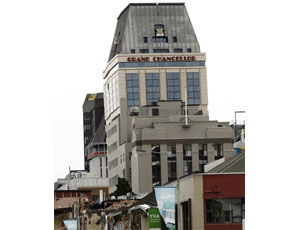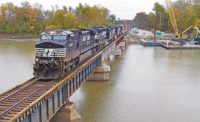Engineers, working with the city, have devised a program of repairs to the 26-story Hotel Grand Chancellor, damaged but still standing in the magnitude-6.3 earthquake Feb. 22 in Christchurch, New Zealand.

At least one engineer, visiting from the U.S., advised the city against the repair as too risky to workers.
After the remediation, owner Grand Hotels International will decide whether the building can be salvaged, say city officials.
The hotel, which dropped about one meter at one end, is considered stable.
The repairs will take three weeks.
Damage to the hotel has prevented investigators from checking other buildings within a 90-m cordon around the hotel.
"The scenes of devastation are horrendous, but as the intensity if shaking has now been suggested to have been at MCE level (a 2,500-year earthquake), that should not be surprising," says John Hare, a local structural engineer.
Modern buildings are designed in New Zealand, as in the U.S., for lower levels of lateral load than occurred in the Feb. 22 Canterbuy quake, with added ductility to account for the potential overload in this sort of rare event, he explains. The ultimate aim is simply avoiding collapse immediately, and even then, demolition may be required afterward, he adds.
"This is not a failing of NZ codes or design, it is recognition that although the magnitude of the earthquake was not high, it's proximity and depth were such that its impact was tremendous, and continued aftershocks compound this," says Hare.
Urban search and rescue engineers, and structural engineers working on behalf of Christchurch City Council have carried out a detailed evaluation of the concrete-framed hotel, which was built in 1975, with additions in 1986 and 1995.
The evaluation shows that the building has tilted because critical supports structures have failed in the southeast part of the building at ground level. Three columns on level 12 have been damaged. Surveys conducted since Feb. 23 have established there has been no subsequent movement in the structure.
It is difficult to assess the building's capacity to resist aftershocks, says Michele Poole, public information manager with the Christchurch earthquake response arm of the city's emergency management team.
"However, the structure is stable and has resisted several strong aftershocks without any signs of further movement," Poole says.
The first repair phase, beginning in the morning on Feb. 28, will focus on the ground floor foyer area, with concrete to be cast into boxed formwork on either side. Then concrete will sprayed on both sides of the wall, further strengthening the damaged wall.
In conjunction with this work, two important beams in the southeast corner will be propped, says Poole.
Following the concrete work, crews will wrap steel jacketing around the damaged columns under level 12, with concrete pumped between the jacketing and the columns to provide strengthening.
By March 2, the structure should be stabilized to the point where USAR personnel can remove the bodies known to be in the building. USAR staff will also be able to survey the block immediately opposite, which includes the Holiday Inn. This area has not been inspected since the quake because of the risk.
The owners of the Grand Chancellor are aware of the proposed work and are eager to see the building's stability improved, says the city. "The stabilization works mean that we can move from emergency response into planning what the future of the Grand Chancellor will be. The owners will be able to take advice from their engineers about whether it is possible to save the building or whether it might need dismantling," says the spokesperson.
There will be a lot of discussion and consideration to follow, that may lead to code change, quite possibly beyond the New Zealand building code, given common design philosophies with others such as the U.S., Hare says. "The world must all learn from this."




Post a comment to this article
Report Abusive Comment